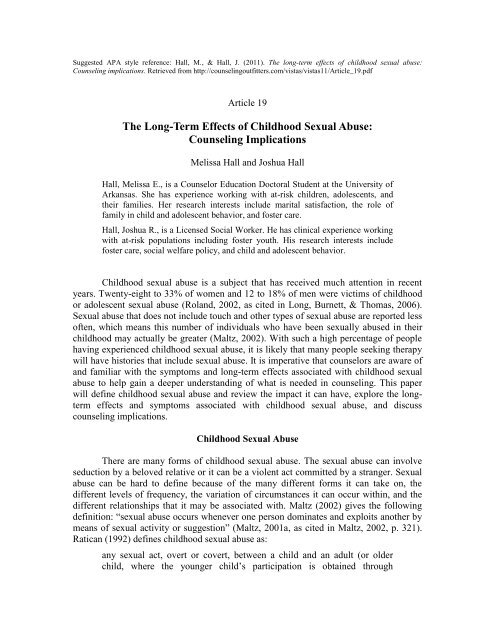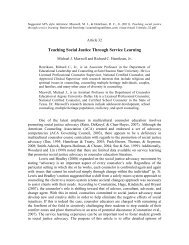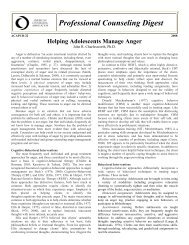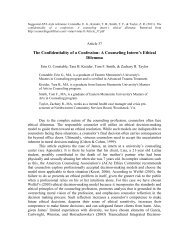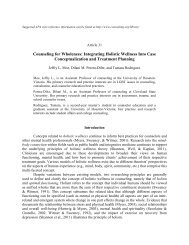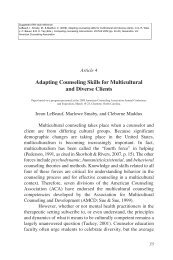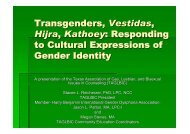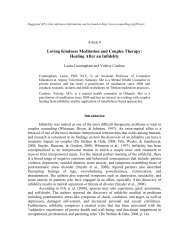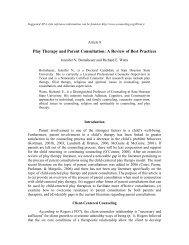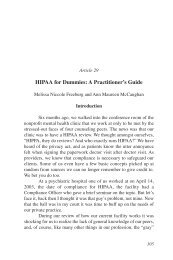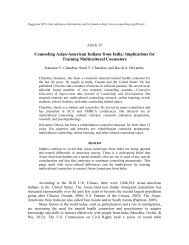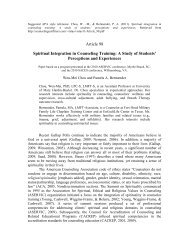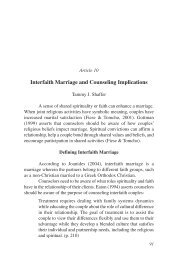The Long-Term Effects of Childhood Sexual Abuse: Counseling ...
The Long-Term Effects of Childhood Sexual Abuse: Counseling ...
The Long-Term Effects of Childhood Sexual Abuse: Counseling ...
You also want an ePaper? Increase the reach of your titles
YUMPU automatically turns print PDFs into web optimized ePapers that Google loves.
Ideas and Research You Can Use: VISTAS 2011themselves. Survivors tend to display more self-destructive behaviors and experiencemore suicidal ideation than those who have not been abused (Browne & Finkelhor,1986).Body issues and eating disorders have also been cited as a long-term effect <strong>of</strong>childhood sexual abuse. Ratican (1992) describes the symptoms <strong>of</strong> child sexual abusesurvivors’ body image problems to be related to feeling dirty or ugly, dissatisfaction withbody or appearance, eating disorders, and obesity. Survivors’ distress may also result insomatic concerns. A study found that women survivors reported significantly moremedical concerns than did people who have not experienced sexual abuse. <strong>The</strong> mostfrequent medial complaint was pelvic pain (Cunningham, Pearce, & Pearce, 1988).Somatization symptoms among survivors are <strong>of</strong>ten related to pelvic pain, gastrointestinalproblems, headaches, and difficulty swallowing (Ratican, 1992).Stress and anxiety are <strong>of</strong>ten long-term effects <strong>of</strong> childhood sexual abuse.<strong>Childhood</strong> sexual abuse can be frightening and cause stress long after the experience orexperiences have ceased. Many times survivors experience chronic anxiety, tension,anxiety attacks, and phobias (Briere & Runtz, 1988, as cited in Ratican, 1992). A studycompared the posttraumatic stress symptoms in Vietnam veterans and adult survivors <strong>of</strong>childhood sexual abuse. <strong>The</strong> study revealed that childhood sexual abuse is traumatizingand can result in symptoms comparable to symptoms from war-related trauma (McNew& Abell, 1995).Some survivors may have dissociated to protect themselves from experiencing thesexual abuse. As adults they may still use this coping mechanism when they feel unsafeor threatened (King, 2009). Dissociation for survivors <strong>of</strong> childhood sexual abuse mayinclude feelings <strong>of</strong> confusion, feelings <strong>of</strong> disorientation, nightmares, flashbacks, anddifficulty experiencing feelings. Denial and repression <strong>of</strong> sexual abuse is believed bysome to be a long-term effect <strong>of</strong> childhood sexual abuse. Symptoms may includeexperiencing amnesia concerning parts <strong>of</strong> their childhood, negating the effects and impact<strong>of</strong> sexual abuse, and feeling that they should forget about the abuse (Ratican, 1992).Whether or not survivors can forget past childhood sexual abuse experiences and laterrecover those memories is a controversial topic. Some therapists believe that sexual abusecan cause enough trauma that the victim forgets or represses the experience as a copingmechanism. Others believe that recovered memories are false or that the client is led tocreate them (King, 2009)Survivors <strong>of</strong> sexual abuse may experience difficulty in establishing interpersonalrelationships. Symptoms correlated with childhood sexual abuse may hinder thedevelopment and growth <strong>of</strong> relationships. Common relationship difficulties that survivorsmay experience are difficulties with trust, fear <strong>of</strong> intimacy, fear <strong>of</strong> being different orweird, difficulty establishing interpersonal boundaries, passive behaviors, and gettinginvolved in abusive relationships (Ratican, 1992). Feinauer, Callahan, and Hilton (1996)examined the relationship between a person’s ability to adjust to an intimate relationship,depression, and level <strong>of</strong> severity <strong>of</strong> childhood abuse. <strong>The</strong>ir study revealed that as theseverity <strong>of</strong> abuse increased, the scores measuring the ability to adjust to intimaterelationships decreased. <strong>Sexual</strong> abuse <strong>of</strong>ten is initiated by someone the child loves andtrusts, which breaks trust and may result in the child believing that people they love willhurt them (Strean, 1988 as cited in Pearson, 1994). Kessler and Bieschke (1999) found a3
Ideas and Research You Can Use: VISTAS 2011significant relationship between women who were sexually abused in childhood and adultvictimization.Many survivors experience sexual difficulties. <strong>The</strong> long-term effects <strong>of</strong> the abusethat the survivor experiences, such as, depression and dissociative patterns, affect thesurvivors sexual functioning. Maltz (2001a, as cited in Maltz, 2002) gives a list <strong>of</strong> the topten sexual symptoms that <strong>of</strong>ten result from experiences <strong>of</strong> sexual abuse: “avoiding,fearing, or lacking interest in sex; approaching sex as an obligation; experiencingnegative feelings such as anger, disgust, or guilt with touch; having difficulty becomingaroused or feeling sensation; feeling emotionally distant or not present during sex;experiencing intrusive or disturbing sexual thoughts and images; engaging in compulsiveor inappropriate sexual behaviors; experiencing difficulty establishing or maintaining anintimate relationship; experiencing vaginal pain or orgasmic difficulties (women); andexperiencing erectile, ejaculatory, or orgasmic difficulties (men; p. 323). A study done onthe prevalence and predictors <strong>of</strong> sexual dysfunction in the Untied States revealed thatvictims <strong>of</strong> sexual abuse experience sexual problems more than the general population.<strong>The</strong>y found that male victims <strong>of</strong> childhood sexual abuse were more likely to experienceerectile dysfunction, premature ejaculation, and low sexual desire, and they found thatwomen were more likely to have arousal disorders (Laumann, Piel, & Rosen, 1999).It is important to point out that although research has shown there to be significantrelationships between long-term effect variables and childhood sexual abuse, eachvictim’s responses and experiences will not be the same. Although it is <strong>of</strong>ten viewed as atraumatic experience, there is no single symptom among all survivors and it is importantfor clinicians to focus on the individual needs <strong>of</strong> the client.<strong>Counseling</strong> Implications<strong>The</strong>re are many important things for a counselor to consider when helping asurvivor overcome long-term effects or symptoms <strong>of</strong> sexual abuse. <strong>The</strong> literatureregarding the therapeutic process after disclosure has been made is limited and nospecific treatment model is suggested (Kessler, Nelson, Jurich, & White, 2004). Althoughno specific treatment model is used for counseling survivors, researchers and clinicianshave provided suggestions and important implications for counselors to consider. Thissection <strong>of</strong> the paper will explore these counseling implications.Kessler et al. (2004) identified common treatment decision-making practices <strong>of</strong>therapists treating adult survivors <strong>of</strong> childhood sexual abuse. <strong>The</strong>ir study revealed thatregardless <strong>of</strong> the treatment mode, the therapists found it important to assess the clientpresenting problems, the effects the abuse has on their current functioning, and how theclient currently copes. Because clients <strong>of</strong>ten have trouble externalizing the abuse,therapists may need to work with client to increase their ability to accurately attributeresponsibility. To help decrease levels <strong>of</strong> depression and anxiety, helpful goals for thesurvivor may be to increase their sense <strong>of</strong> control and increase their ability to accuratelyattribute responsibility (Hartman et al., 1987).<strong>The</strong> therapeutic alliance is imperative to help counseling survivors feel safe.<strong>Childhood</strong> sexual abuse survivors <strong>of</strong>ten present with symptomatic problems, feelings, andbehaviors that result from the abuse, rather than for the sexual abuse itself (Courtois1988, as cited in Ratican, 1992). Feelings <strong>of</strong> fear or vulnerability may hinder the client4
Ideas and Research You Can Use: VISTAS 2011from disclosing their childhood sexual abuse. Relationship building techniques such asusing encouragement, validation, self-disclosure, and boundary setting are encouraged tohelp build the therapeutic alliance. Accepting the survivor’s version <strong>of</strong> their sexual abuseexperience is <strong>of</strong>ten therapeutic and helps strengthen the alliance (Pearson, 1994). It isimportant for the counselor to allow the client time to build feelings <strong>of</strong> trust, safety, andopenness. Because sexual abuse is abusive in power by nature egalitarianism is stressedas an important factor. Allowing the client to have control in both the pace and direction<strong>of</strong> the therapeutic process is important (Ratican, 1992).Client empowerment is a technique used with survivors. Van Velsor and Cox(2001) suggest it is vital to help survivors process, uncover, and express anger becauseanger can be used to help a client feel empowered, appropriately attribute responsibility,establish boundaries, and promote self-efficacy and power. <strong>The</strong>y recommend that thecounselor help the client reframe their anger into an emotion they can use to help definetheir rights and needs, explore the covert norms for anger expression among women, andhelp survivors use their anger for productive action and behavior.Assisting the client in gaining skills that will help them find and developsupportive relationships, especially with a partner, is also considered an important goal inhelping a survivor overcome some <strong>of</strong> the long term effects <strong>of</strong> childhood sexual abuse.Helping the client gain skills that will help them better adjust to, enhance, and developintimate relationships may be an important step in counseling a survivor <strong>of</strong> childhoodsexual abuse. In a study conducted by Feinauer et al. (1996), it was revealed that thebetter a survivor was able to adjust to intimate relationships, the lower their depressionscores were despite the level <strong>of</strong> abuse they experienced. <strong>The</strong> authors suggest that positiveintimate relationships may increase the survivors’ feelings <strong>of</strong> safety, help them gaininterpersonal experience, and experience reconnection.If the survivor is in a committed, long-term relationship, it is important for thesurvivor’s partner to also become educated about the long-term effects <strong>of</strong> childhoodsexual abuse and learn ways they can actively participate in the healing process.Counselors can help couples learn to integrate communication, choice, trust, respect, andequality into their intimate relationship (Maltz, 2002). Feinauer et al. (1996) suggest thatthe therapeutic goals for a couple include resolution <strong>of</strong> issues related to physical andemotional safety, resolution <strong>of</strong> distressing memories, increased trust between survivorand partner, understanding <strong>of</strong> survivors symptoms, and participation in appropriate socialreconnection.<strong>The</strong>rapists are recommended to address the more general psychosocial problemsbefore treating the sexual problems <strong>of</strong> survivors. This is due to the sensitive andvulnerable nature <strong>of</strong> sex. Survivors are more likely to experience success in sex andrelationship counseling after resolving feelings about the abuse and gaining skills in areassuch as assertiveness and self-awareness (Maltz, 2002).Maltz (2001a, as cited in Maltz, 2002) suggests that a first step in sexual healingis to help the survivor connect their current sexual problems with their past sexual abuse.It may help for the survivor to see a list <strong>of</strong> the sexual symptoms that <strong>of</strong>ten are from pastsexual abuse. Ratican (1992) describes the sexual symptoms <strong>of</strong> survivors to <strong>of</strong>ten includesexualizing relationships, inappropriate seduction, difficulties with affection andintimacy, compulsive sexual behavior, promiscuity, problems concerning desire, arousal,and orgasm, flashbacks, difficulties with touch, and sadistic/masochistic tendencies.5
Ideas and Research You Can Use: VISTAS 2011A treatment designed for sexual healing <strong>of</strong>ten focuses on understanding how thesexual abuse influenced their sexuality, adjusting sexual attitudes, gaining a morepositive sexual self-concept, decreasing negative sexual behaviors, learning how to copewith negative reactions to touch, and developing skills to positively experience touch andsexual intimacy (Maltz, 2002).ConclusionIt is important that research continue on the topic <strong>of</strong> the long-term effects <strong>of</strong>childhood sexual abuse. <strong>The</strong> severity <strong>of</strong> this issue and the significant implications it hason the lives <strong>of</strong> survivors has been well established. With this knowledge it is imperativethat counselors continue to expand their knowledge <strong>of</strong> childhood sexual abuse. <strong>The</strong>re ismuch to be learned on how counselors and therapists can best help survivors <strong>of</strong> childhoodsexual abuse overcome its long-term effects. Further research is needed to address bestpractice and treatment interventions for survivors. <strong>Childhood</strong> sexual abuse is obviously<strong>of</strong>ten a traumatic experience that has many consequences throughout the person's life.<strong>The</strong> effects <strong>of</strong> childhood sexual abuse last into adulthood and counselors need to be welltrained in order to provide the best services possible.ReferencesBrowne, A., & Finkelhor, D. (1986), Impact <strong>of</strong> child sexual abuse: A review <strong>of</strong> theresearch. Psychological Bulletin, 99, 66-77.Cunningham, J., Pearce, T., & Pearce, P. (1988). <strong>Childhood</strong> sexual abuse and medicalcomplaints in adult women. Journal <strong>of</strong> Interpersonal Violence, 3, 131-144.Feinauer, L., Callahan, E. & Hilton, H. G. (1996). Positive intimate relationshipsdecrease depression in sexually abused women. American Journal <strong>of</strong> Family<strong>The</strong>rapy, 24(2), 99-106.Hartman, M., Finn, S., & Leon, G. (1987). <strong>Sexual</strong>-abuse experiences in a clinicalpopulation: Comparisons <strong>of</strong> familial and nonfamilial abuse. Psychotherapy:<strong>The</strong>ory, Research, Practice, Training, 24(2), 154-159.Kessler, B., & Bieschke, K. (1999). A retrospective analysis <strong>of</strong> shame, dissociation, andadult victimization in survivors <strong>of</strong> childhood sexual abuse. Journal <strong>of</strong> <strong>Counseling</strong>Psychology, 46(3), 335-341.Kessler, M. R. H., Nelson, B., Jurich, A., & White, M. (2004). Clinical decision-makingstrategies <strong>of</strong> marriage and family therapists in the treatment <strong>of</strong> adult childhoodsexual abuse survivors. American Journal <strong>of</strong> Family <strong>The</strong>rapy, 32(1), 1-10.King, B. M. (2009). Human sexuality today (6 th ed.). Upper Saddle River, NJ: Pearson.Laumann, E., Pail, A., & Rosen, R. (1999). <strong>Sexual</strong> dysfunction in the United States:Prevalence and predictors. Journal <strong>of</strong> American Medical Association, 281, 537-544.<strong>Long</strong>, L. L., Burnett, J. A., & Thomas, R. V. (2006). <strong>Sexual</strong>ity counseling: An integrativeapproach. Upper Saddle River, NJ: Pearson.Maltz, W. (2002). Treating the sexual intimacy concerns <strong>of</strong> sexual abuse survivors.<strong>Sexual</strong> and Relationship <strong>The</strong>rapy, 17(4), 321-327.6
Ideas and Research You Can Use: VISTAS 2011McNew, J., & Abell, N. (1995). Posttraumatic stress symptomatology: Similarities anddifferences between Vietnam veterans and adult survivors <strong>of</strong> childhood sexualabuse. Social Work, 40(1), 115-126.Pearson, Q. (1994). Treatment techniques for adult female survivors <strong>of</strong> childhood sexualabuse. Journal <strong>of</strong> <strong>Counseling</strong> & Development, 73(1), 32-37.Ratican, K. (1992). <strong>Sexual</strong> abuse survivors: Identifying symptoms and special treatmentconsiderations. Journal <strong>of</strong> <strong>Counseling</strong> & Development, 71(1), 33-38.Van Velsor, P., & Cox, D. (2001). Anger as a vehicle in the treatment <strong>of</strong> women who aresexual abuse survivors: Reattributing responsibility and accessing personal power.Pr<strong>of</strong>essional Psychology: Research and Practice, 32(6), 618-625.Note: This paper is part <strong>of</strong> the annual VISTAS project sponsored by the American <strong>Counseling</strong> Association.Find more information on the project at: http://counselingoutfitters.com/vistas/VISTAS_Home.htm7


